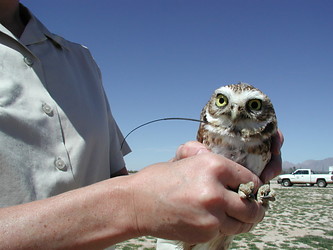Introduction


Athene cunicularia. © 2005 Lirain Urreiztieta, Arizona Game and Fish Department
Widely distributed throughout most of the western United States, Western Burrowing Owls1 are small, and like other owls they have cryptic plumage to help camouflage them. They roost and nest in underground burrows in open grasslands and prairies, as well as other areas characterized by sparse vegetation. Due to noticable population declines across most of its range, wildlife researchers are investigating potential causes for these declines and are focusing efforts to protect valuable habitat.
Species Description
The Burrowing Owl is widely considered an opportunistic feeder taking a myriad of prey items ranging from other birds, through the spectrum of smaller vertebrates and invertebrates. The owl's selection of open habitat, lacking dense vegetation and cover, provides the owl high visibility, both for specific foraging needs and predator detection. This owl’s unique underground nesting and roosting requirements demand the availability of burrows, which were historically specific to fossorial mammal burrows, but are more recently, in some regions, as varied as concrete crevices, culverts and Artificial Burrow Systems.

.250a.jpg)
Athene cunicularia hypugea. © 2005 Lirain Urreiztieta
Research
In response to Burrowing Owl population declines, understanding juvenile dispersal movements has been identified as a primary research need. Development in the Greater Tucson Area has led to concerns about the status of local Burrowing Owl populations. Maintaining movement corridors between populations is essential to facilitate population persistence in Tucson’s growing urbanized landscape.
The Arizona Game and Fish Department initiated a study focused on describing movement patterns and identifying movement corridors. The study area was comprised of five distinct sites within the Greater Tucson Area.
Juvenile owls at these sites were captured and radio marked, and then were tracked on the ground using radio receivers and antennas. Fixed wing aircraft outfitted with radio tracking equipment were also used to supplement ground efforts to locate owls making long distance movements.
Discussion and Conclusion
The research found that owl movements across the urban matrix are possible, given the current level of habitat connectivity in the Greater Tucson Area. There was high variation in distance between movements and dispersal distances. This could be linked to variation in prey abundance and availability of suitable burrows along dispersal areas and movement corridors. The conservation of the Santa Cruz River as a geographic corridor is essential to recruitment between local populations as it connects clusters of owls in Marana to owls in the Santa Cruz River Complex and Davis-Monthan Air Force Base via a high use area of light industry.
In managing for the Burrowing Owl, we recommend intensifying regional banding and re-sighting efforts in combination with telemetry studies such as this to help identify additional dispersal corridors and prioritize conservation of known corridors in the Greater Tucson Area. Furthermore, the use and effectiveness of artificial burrows to enhance linkages should be explored.
1Scientific name: Athene cunicularia hypugea



 Go to quick links
Go to quick search
Go to navigation for this section of the ToL site
Go to detailed links for the ToL site
Go to quick links
Go to quick search
Go to navigation for this section of the ToL site
Go to detailed links for the ToL site